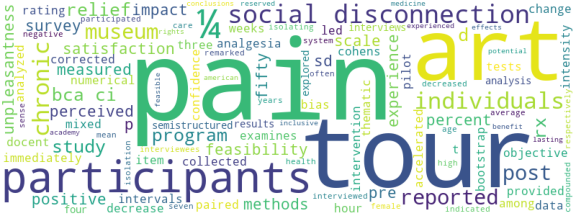| Id | 707 | |
| Author | Koebner I.J., Fishman S.M., Paterniti D., Sommer D., Witt C.M., Ward D., Joseph J.G. | |
| Title | The art of analgesia: A pilot study of art museum tours to decrease pain and social disconnection among individuals with chronic pain | |
| Reference | Koebner I.J., Fishman S.M., Paterniti D., Sommer D., Witt C.M., Ward D., Joseph J.G.; The art of analgesia: A pilot study of art museum tours to decrease pain and social disconnection among individuals with chronic pain ;Pain Medicine (United States) vol:20 issue: 4.0 page:681 |
|
| Link to article | https://www.scopus.com/inward/record.uri?eid=2-s2.0-85064190528&doi=10.1093%2fpm%2fpny148&partnerID=40&md5=26f0776fda8046846488c86a5b6b56f6 |
|
| Abstract | Objective. This mixed-methods study examines the feasibility of art museum tours (Art Rx) as an intervention for individuals with chronic pain. Methods. Art Rx provided 1-hour docent-led tours in an art museum to individuals with chronic pain. Survey data were collected pre-tour, immediately post-tour, and at three weeks post-tour. Pain intensity and unpleasantness were measured with a 0-10 numerical rating scale. Social disconnection was measured with a 12-item social disconnection scale. Participants also reported percent pain relief during the tour and program satisfaction in the post-tour survey. Change in pain and social disconnection was analyzed with paired t tests, bias-corrected and accelerated bootstrap confidence intervals (BCa CIs), and Cohens d. Thematic analysis of semistructured interviews with participants explored the feasibility and perceived impact of the program. Results. Fifty-four individuals participated in this study (mean age SD ¼ 59 14.5 years, 64.8% female), and 14 were interviewed. Fifty-seven percent of participants reported pain relief during the tour, with an average pain relief (SD) of 47% (34.61%). Participants reported decreased social disconnection and pain unpleasantness pre- to post-tour (3.65, BCa 95% CI ¼ 1.70-5.73, P < 0.001, d ¼ 0.37; and 0.49, BCa 95% CI ¼ 0.06-0.90, P ¼ 0.016, d ¼ 0.20, respectively). Participants indicated high satisfaction with the program. Interviewees remarked on the isolating impact of chronic pain and how negative experiences with the health care system often compounded this sense of isolation. Participants experienced Art Rx as a positive and inclusive experience, with potential lasting benefit. Conclusions. Art museum tours for individuals with chronic pain are feasible, and participants reported positive effects on perceived social disconnection and pain. © 2018 American Academy of Pain Medicine. All rights reserved. |
|
| Keywords | Analgesia; Art; Museum; Pain; Public Health; Social Context |
Wordcloud:



